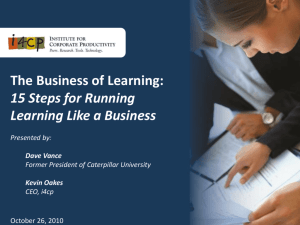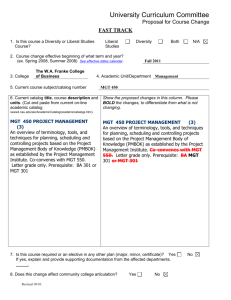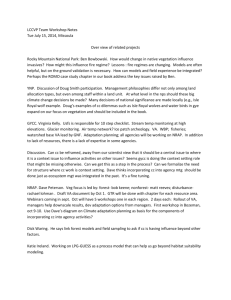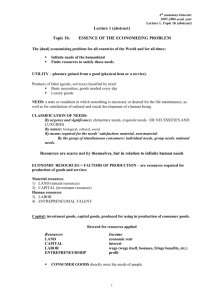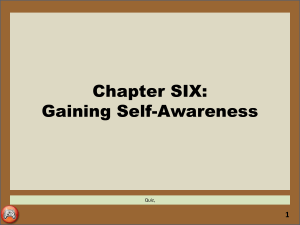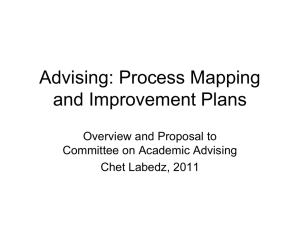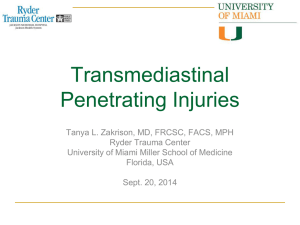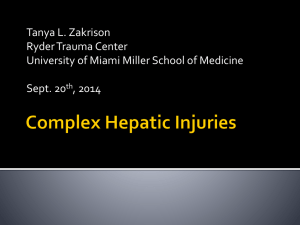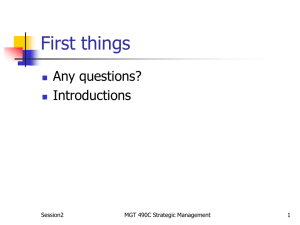15 Steps to Running Learning Like a Business
advertisement
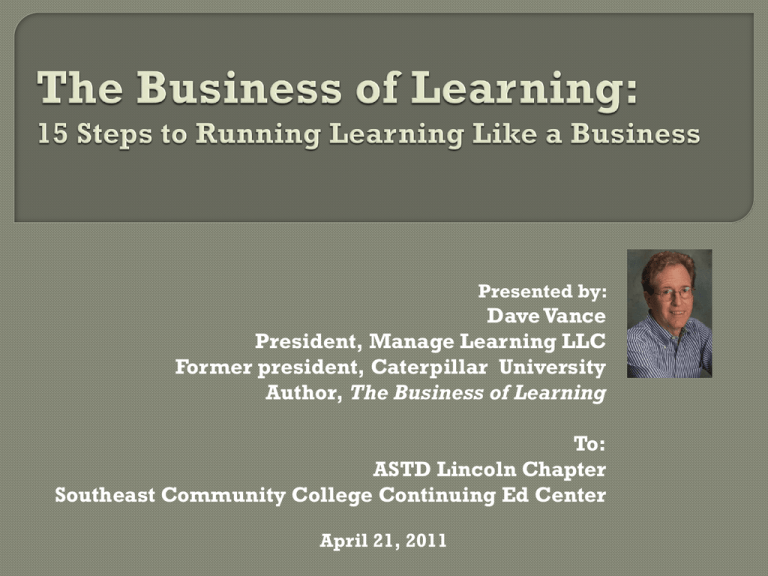
Presented by: Dave Vance President, Manage Learning LLC Former president, Caterpillar University Author, The Business of Learning To: ASTD Lincoln Chapter Southeast Community College Continuing Ed Center April 21, 2011 Strategic and planned proactively (before the year begins) Strategic but planned just in time Timely but not necessarily strategic Most is not strategic and should have been planned sooner 2 1. 2. Appreciate that learning is a business Resolve to run it like a business Implies that Learning should produce measurable results Must be planned carefully And executed with discipline Also, that numbers will be involved! 3 3. Adopt a strategic focus 4. Create a board of governors 5. Create vision and mission statements 6. Create a multi-year plan to achieve your vision This will be your journey Manage expectations Communicate 4 5 7. Ensure that your organizational structure will support a strategic focus 8. Centralized or hybrid Adopt a workable funding model Often will be a combination of corporate, allocation and discretionary (charge back) 6 Start with the business and strategic plan Meet with the CEO, senior leaders, key stakeholders • Understand company goals and challenges • Learn the priorities • These are business discussions 7 Perform a “macro” level needs analysis to determine if learning has a role to play in achieving these goals Make a preliminary determination of recommended learning programs and their alignment to the prioritized company goals 8 #1 Strategic Goal Increase Sales #2 Reduce Defects 20% Design course for engineers 5 2 200 #3 Reduce Injuries 25% Safety courses for mfg ee's Safety courses for mgt ee's 5 2 5 1 2,500 600 Swilthe Mfg #4 Improve Leadership +5 pts Leadership for supervisors 1 0 180 Wang Strategy #5 Increase Retention 5,000 2,500 ====== 5,000 Driese HR Top Five Goals Metric Learning Program 10% Consultative selling skills for ee's Product program for employees Courses to Number of Support Goal Unique Sponsor New Existing Participants VP Division 1 0 100 Ortega Sales 3 2 100 +5 pts Individual development plans Performance mgt course for ee's 10 ==== 27 20 ==== 30 D'Agoto Quality 9 The business case brings together the expected impact (and perhaps benefits) of the recommended learning and the costs • Impact: Increase in sales, reduction in injuries, or an increase in productivity (often these can be dollarized) • Cost: Budget costs (design, development, delivery, reinforcement) and opportunity cost • Net benefit or ROI (if appropriate) 10 Expected Unique 2011 Impact of Partici Priority Corporate Goal Target Learning pants 1 Increase Sales 10% 5% 100 2 Reduce Defects 20% 14% 200 3 Reduce Injuries 25% 15% 3,100 4 Improve Leadership +5 pts +2 pts 180 5 Increase Retention +5 pts +1.5 pts 5,000 Subtotal Top Five Prioities 5,000 Total Partici pants 1,100 800 13,600 180 7,500 23,180 Gross BudgetOpportunityTotal Net Benefits Costs Costs Benefit (thous.) (thous.) (thous.) (thous.) $1,500 $490 $117 $893 $2,100 $570 $512 $1,018 $1,200 $410 $376 $415 $1,200 $582 $302 $316 $1,800 $340 $1,150 $310 $7,800 $2,392 $2,457 $2,952 Subtotal Other Goals Total All Goals 1,950 5,000 4,725 27,905 $3,050 $10,850 $1,245 $3,637 $778 $3,234 $1,028 $3,980 Unaligned Learning Other Costs (not included elsewhere) 4,000 4,000 ====== 5,000 ====== 31,905 $700 NA ====== $11,550 $300 $400 $600 $0 ====== ====== $4,537 $3,634 $0 -$600 ====== $3,380 Grand Total for All Learning 11 Priority 1 Organization Objective Key Learning Programs Target Audience Increase customer satisfaction Customer service skills (new) score by 10% 2 3 Reduce complaints by 20% Reduce Injuries by 25% Call center employees 20 20 New services information (revised) Call center employees 20 20 Total key programs 40 40 Billing course (new) 10 10 Service Sched. & Mgt course (new) Logistics employees Accounting employees 15 15 Total key programs 25 25 500 Five Safety courses (3 new) Transportation ee's 100 One Safety course (revised) Division managers 15 15 Two Safety courses (1 new) Office employees 250 500 365 1,015 Total key programs 4 Improve leadership Intro to supervision (revised) New supervisors 10 10 score by 5 points Leadership for managers (new) Division managers 15 15 on employee survey Advanced leadership (existing) Department heads 5 5 30 30 Total key programs 5 Expected % Unique Total Impact on Participants Participants Corp Obj Impact of Learning Increase retention by Individual development plans All employees 550 550 10 points Performance mgt (new) Mgt employees 285 285 Total key programs Total for Top Five Priorities Learning for Top Five Objectives Thousands of Dollars OpportBudget unity Total Cost Cost Cost 50% 5% higher customer satisfaction $25 $19 $44 70% 14% reduction in complaints $35 $14 $49 60% 15% reduction in injuries $65 $45 $110 40% 2 point increase $35 $40 $75 3 point increase 835 835 30% ====== ====== ==== 1,295 1,945 Range = 30%-70% $18 $32 $50 ====== ====== ====== $143 $110 $253 Courses: 9 New , 3 Revised 12 Yes, of course Yes, but is is not a written document No, not really We’re working on that now We’re moving in that direction 13 Ideally, a written document with the following chapters: • Executive Summary • Last Year’s Accomplishments • Strategic Alignment • Business Case for Learning • Learning Resources, Expenditures, Budget • Detailed Work Plans • Evaluation Strategy 14 Created with input from CEO, governing bodies, stakeholders, learning professionals Approved by CEO and governing body Very scalable: An L&D function with just one person can still do this 15 Create scorecards to measure progress against goals Calendar at least one staff meeting per month dedicated to a review of your progress Share progress at least quarterly with the board of governors and/or CEO 16 Corporate University Effectiveness Scorecard Results Through June 10 Actual Plan For 2011 Jun YTD % Plan Forecast Impact Total Participants Number 40,000 50,000 22,013 44% 48,000 Number 20,000 23,000 11,854 52% 24,000 # Particip. 5,000 10,000 6,009 60% 11,000 % % # Particip. -10% NA 1,000 -20% -14% 5,000 -17% -12% 2,089 42% -20% -14% 4,000 % % # Particip. -5% NA 200 -10% -5% 1,000 -6% -3% 423 42% -8% -4% 700 % % 2% NA 10% 4% 4% 2% On 6 point scale On 6 point scale 4.8 4.5 5.1 5.0 5.2 4.8 Learning % passed 85% 90% 87% 88% Application % 60% 70% 72% 74% Unique Participants Top Priority Programs Safety Reduction in Injuries Corporate Impact of training (70%) Quality Reduction in Defects Corporate Impact of training (50%) Marketing Increase in Sales Corporate Impact of training (40%) 8% 3% Feedback Participant Sponsor/Owner 102% 96% 5.1 4.8 17 Start with the basics and add as you go Sample strategy: • Level 0: number of participants, courses, completion dates, costs All courses • Level 1: reaction All courses, not necessarily all participants • Level 2: learning Where appropriate. All compliance courses 18 Sample strategy (continued): • Level 3: application Select courses • Level 4: impact A few key courses • Level 5: ROI or Net Benefit A few key courses Purpose: Ensure results and improve 19 14. Use business and economic concepts to make better decisions 15. Like opportunity cost and marginal analysis Benchmark with others. Learn. Improve. Remember, it is a multiyear journey. The goal is continuous improvement 20 Dave Vance dave@poudrerivergroup.com Resources The Business of Learning: How to Manage Corporate Training to Improve Your Bottom Line by Dave Vance Available at poudrerivergroup.com or at Amazon.com A 36-page Sample Business Plan for Learning (PDF, Word and Excel files) available at poudrerivergroup.com 21
